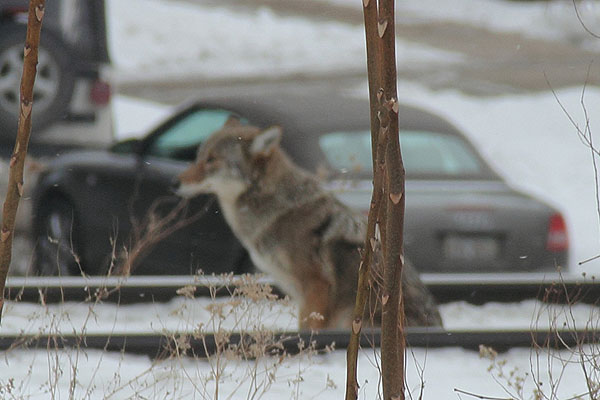
Coyote on the Metra tracks near Berteau Street, 2011
This morning I awoke to another news report on urban coyotes, this time on NPR, about Chicago coyotes who are waking the neighbors by howling in tune to ambulance sirens. This comes on the heels of a one-year-old female picked up from the LaSalle overpass near Stockton Drive which, as Marcia Froelke Coburn describes, was picked up by Animal Care and Control, delivered to Flint Creek Wildlife Rehabilitation, and later released into the wild, just as Holly the ice floe coyote was:
Holly’s story tugged at the heartstrings of many people – both in the Chicago area as well as nationally. Her rescue was a great example of human capacity for compassion. But despite her heroic rescue and the media surrounding both her rescue and release, just days after her release we were faced with another coyote witch-hunt in which someone alleged, devoid of basis in fact, that a coyote was vicious, thus resulting in an organized effort to contain it. Fortunately, cooler and more erudite heads prevailed and the coyote, after hours of being tracked, was finally left alone to go back to its life.
I understand their concern, but on the whole we’ve become more humane about coyotes. In one of the best pieces about the phenomenon I’ve read, the late Jerry Sullivan, author of the Reader‘s "Field and Street" column, described Americans’ ongoing (and failed) attempts to eliminate the coyote:
The practice of encouraging citizens to kill animals considered destructive goes way back. As Americans moved out of the eastern forests and onto the prairies, their attention shifted from the timber wolves of the east to the smaller "brush wolves" of the plains. Iowa had a $2 bounty on coyotes as early as 1795–long before there was an Iowa. To collect you had to find a territorial judge and give him the head of the animal you’d killed. Over the years bounties have been so successful at encouraging the slaughter of annoying animals that local governments have often had to suspend them because they were emptying the treasury.
Sullivan speculates that extermination efforts against coyotes failed where those against wolves succeeded because they’re better suited to avoid humans, being more solitary than wolves and requiring less range: "Wolves require very large territories; a pack may roam across 100 square miles. Coyotes can get by on a few thousand acres, at times even less. One study in Los Angeles suggested that a lone coyote could get by on as little as 200 acres."
To be fair, coyotes do represent a risk for farmers, so the fear may reflect the agricultural history of our country and region. A more immediate problem might seem to be domestic animals, but according to a recent paper (PDF) by Stanley Gehrt, a professor at Ohio State and director of Chicago’s Coyote Project (which was just coming into being when Sullivan wrote his piece), scientists haven’t found that domestic animals make up much of the typical urban coyote’s diet:
Coyote predation on pets is a major contributor to human-coyote conflicts, but domestic cat or dog are consistently found in low frequencies in dietary studies (Table 3). The highest published frequency of occurrence for domestic cat in the coyote diet was only 13% for an urban area in Washington State (Quinn 1997b). This indicates that coyotes may not always consume cats or dogs that are killed by them, and that coyotes in urban areas are not dependent on pets for food.
All in all, Gehrt suggests that they’re not something to worry about much:
The picture that emerges is of an animal that largely avoids people, either temporally or spatially, even while living in close proximity to them within the urban landscape. This is in sharp contrast to the picture of coyotes drawn from only media accounts that necessarily focus on human-coyote incidents.
Which isn’t to say that they’ve never attacked people; in a separate paper (PDF), Gehrt and Lynsey White found "142 reported attack incidents resulting in 159 victims bitten by coyotes during 1960–2006," mostly in California, Arizona, British Columbia, and Alberta.
Related: Bryan Smith on critter hunter Rick Wilberscheid and his fellow licensed wildlife operators, for whom coyotes are a rare occurrence, even compared to muskrats:
In 2006 alone, Illinois nuisance wildlife operators like Wilberschied caught 16,000 raccoons, 15,000 squirrels, 5,000 striped skunks, 6,000 opossums, 1,200 muskrats, 300 coyotes, and too many bats and birds to count.
Photograph: Daniel X. O’Neil (CC by 2.0)



